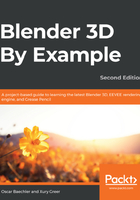
Modern Kitchen - Part 2: Materials and Textures
We've finished the modeling stage of our kitchen scene, but all of the objects are gray and boring to look at. A real kitchen is full of colors and materials such as metal, marble, and wood. This is the perfect opportunity to explore one of the finest additions to Blender 2.8: the Eevee renderer.
As we learned earlier in this book, rendering lets us turn our boring gray scene into a beautiful final result. We have several renderers available to us, but Eevee is a fantastic choice because it can render in real time by using techniques employed in modern game pipelines. The lights, settings, materials, and textures we'll add in this chapter will directly translate to modern game engines such as Unity and Unreal.
Eevee uses Physically-Based Rendering (PBR), which simplifies materials and lighting down to a handful of variables in the real world. We'll modify these settings with nodes, which give us powerful mathematical control over textures to control these variables, and determine how these textures interact with our geometry. Lastly, we'll use these tools to approach problems of aesthetics, trusting our eyes and our gut as we compare results to reference and patterns in nature.
First, we'll learn to navigate the complexities of Blender's node interface with some testing shaders and textures. We'll use these skills to create a variety of complex materials, which we'll then add to our kitchen scene. Last, we'll set up Eevee for real-time goodness, and try out a variety of custom lighting setups. The project files for this chapter , which should be examined in depth for the more complex node trees, can be found in https://github.com/PacktPublishing/Blender-3D-By-Example-Second-Edition/tree/master/Blender3DByExample_ch06.
For more information on getting your real-time Blender assets into the Unity game engine, check out Hands-On Unity 2018.x Game Development for Mobile (Packt), by Raymundo Barrera.
The following topics will be covered in this chapter:
- Simple materials and the nodal workflow
- The Eevee renderer and physically-based materials
- Navigating Blender's node interface
- Manipulating procedural textures
- Creating procedural and texture-based materials